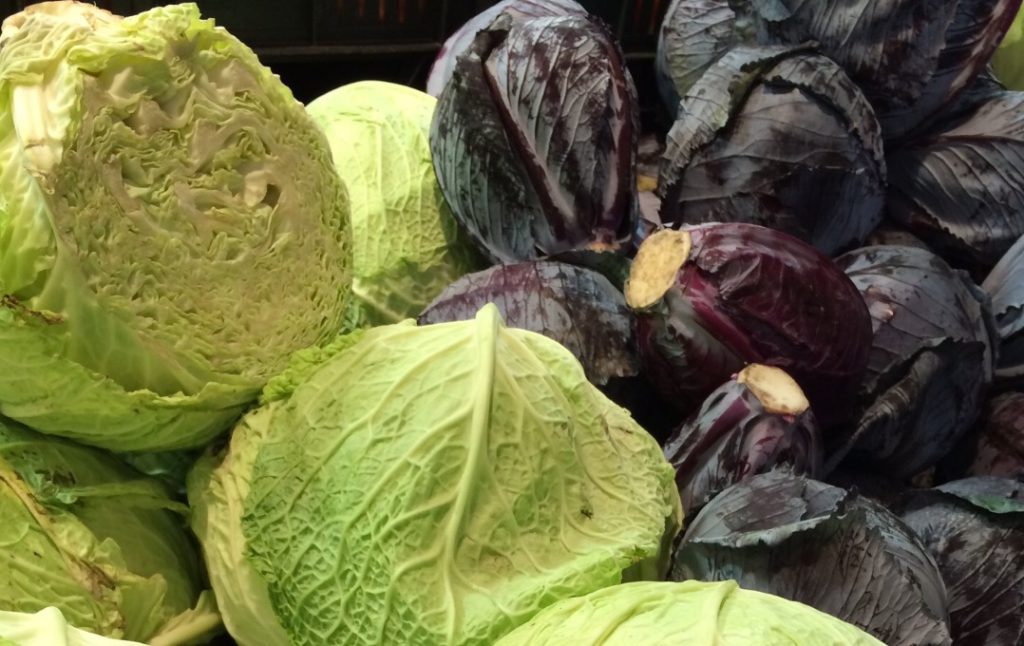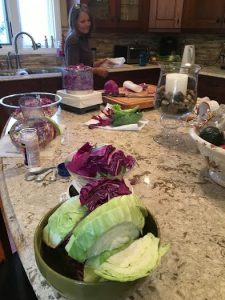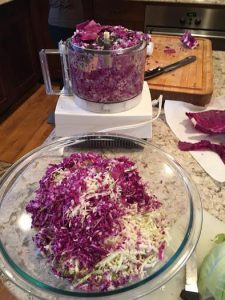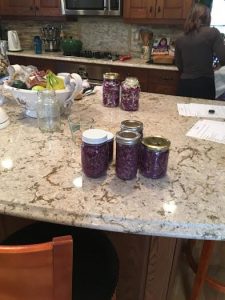
My friend, Barbara Younger, is the author of a fantastic blog called Friend For The Ride. Be sure to check it out. We have a mutual good friend, Gail Crane, who has just learned how to make fermented foods.
Many people are interested in fermentation because it improves digestion and overall gut health.
Gail wrote a post for Friend For The Ride about her fermentation party and so I am reposting it for you. Gail makes fermentation sound so easy!
I didn’t grow up eating fermented foods. Did you?
Happy fermenting!
Sauerkraut Party: Here’s to Healthy Eating!
A guest post from our friend Gail Crane:

Growing up, I remember my mom opening a can of sauerkraut and heating it up for dinner. I didn’t like it and refused to eat it. But I am significantly older now, and my tastes have changed along with my interest in healthier eating. My stomach issues have led me to do research on ways to heal my stomach. And that has led me to fermented foods.
Much is being published about how having a healthy gut is important for our overall health. Eating fermented, probiotic foods—sauerkraut, yogurt, raw cheese, kimchi, natto, tempeh, miso, pickled vegetables and fruits and Kombucha—promotes gut health, which helps us have a stronger immune system.
So my friends Emily and Carol, who are also interested in eating healthier, and I decided to get together to make a batch of sauerkraut. A sauerkraut party! Ok! Lets get this party going! Get your hands in the bowl of cabbage and massage and squeeze!


Fermented sauerkraut is made with brine and not vinegar. It really is very easy to make especially thanks to the many recipes online.
This is how we make our sauerkraut:
3 pounds purple or green organic cabbage (We used a combination of purple and green cabbage.)
1 ½ tablespoons of kosher or celtic sea salt
Shred or cut the cabbage and put into a large mixing bowl. Add the salt and massage and squeeze the cabbage with your hands for approximately 10 minutes until the cabbage becomes watery and limp.
Next, put the cabbage into canning jars and pack it in tightly by pressing it down with your fist. You want the cabbage to have some liquid covering it. Then cover it with a leaf of the cabbage to keep it under the liquid.
Put the lids on the jars (not tight) and sit them in a pan or on a plate (the fermenting will cause them to overflow). Let them sit out of direct sunlight and at a temperature of 65 to 75 degrees, and let the fermenting begin. We have found that it takes 2-3 weeks for the cabbage to taste fermented, but you can start tasting it sooner. Once fermented, tighten the lids and keep in the refrigerator for 2 months or longer. Emily, Carol, and I like our sauerkraut cold instead of warmed up.

This was a very different type of party and a time of fun and conversation as we made a healthy food for ourselves and our families. You should try it! (Look up recipes online as they have a lot of necessary and helpful hints to make successful sauerkraut.)
Gail Crane is a long-time friend who is spending her retirement trying out lots of new ventures such as making fermented foods, mixing up her own skin care products, and learning to paint with acrylics with Barbara.
??????????????????????
?For my local friends….RambleRill Farm is hosting two fermentation workshops. Click here for more information and to register.
Sign up here to receive my weekly posts. I would love to share my musings with you! I will happily email you a cookbook with recipes created by fellow health coach friends. Cheers!
?Would you like to design a new and healthy lifestyle? Let me help. Contact me for health and wellness coaching. We can work together in person or over the phone.?

Loved reading Gail’s post again and seeing the wonderful cabbage pictures. My mom’s family was Pennsylvania Dutch, and they loved sauerkraut. I wish I could go back in time and taste theirs. It was often present at family dinners, but sadly, in my youth, I did not take a bite. Love it now!
I don’t remember eating any fermented foods. I wonder why our generation got away from it! Back in vogue now. And healthy to boot!